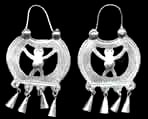
The Mapuche Plattery is based in its religious beleifes. Each piece has a special meaning, that trascends with the ornamental and has a magical value, for example, the "Kaskavilla" was the magical instrument that was used by the Machi to keep away bad spirits and the "Silver belt" allowed the bonding with the gods. The material used was silver with melting techniques and laminated with cold or hot percussion.
Retrafe or silversmith was the name of the man that realized traditionally this duty.
Chilean coins were also used, being laminated by beats.
The name of the pieces that make the trousseau is: Trarilonko (hair lace), Lloven Nitrowe (women´s ornament), Chaway (earings), Traripel (neck fitting), Tupu y Katawe (clothe pin) Kilkai (hanging necklace) Sükill or Trapelakucha (chest pendant), Pentreor (chest hanging of three chains). Equestrian accesories like the Ispuela (spur), Istipu (stirrup) or all of the ironwork (rein, pitch and the break) called in mapudungun Witram plata, Kafishatu and Ketrel piriña.

The dual organization of the Mapuche Worldview influences also in the material demostration of silverware. It explore two diferent worlds: the woman one, support of the symbolic Mapuche speech, in which the Ad Mapu tradition hides, through the written worldview in the forms and contents drawn in the silverware; and the masculine one, personified herness of the horse that represent the sumission of shapes and Huinka contents to the dominant Mapuche descendents.
«In Argentina, the Mapuche people say, that Moon, after a great argument with the Sun, spilled its tears, that were so hot that they became silver. The Mapuche people then picked them and took care of them through all the wonderful and magical forms of silversmithing»